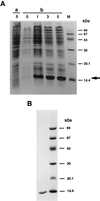Engineering subunit association of multisubunit proteins: a dimeric streptavidin
- PMID: 9177186
- PMCID: PMC21018
- DOI: 10.1073/pnas.94.12.6153
Engineering subunit association of multisubunit proteins: a dimeric streptavidin
Abstract
A dimeric streptavidin has been designed by molecular modeling using effective binding free energy calculations that decompose the binding free energy into electrostatic, desolvation, and side chain entropy loss terms. A histidine-127 --> aspartic acid (H127D) mutation was sufficient to introduce electrostatic repulsion between subunits that prevents the formation of the natural tetramer. However, the high hydrophobicity of the dimer-dimer interface, which would be exposed to solvent in a dimeric streptavidin, suggests that the resulting molecule would have very low solubility in aqueous media. In agreement with the calculations, a streptavidin containing the H127D mutation formed insoluble aggregates. Thus, the major design goal was to reduce the hydrophobicity of the dimer-dimer interface while maintaining the fundamental structure. Free energy calculations suggested that the hydrophobicity of the dimer-dimer interface could be reduced significantly by deleting a loop from G113 through W120 that should have no apparent contact with biotin in a dimeric molecule. The resulting protein, containing both the H127D mutation and the loop deletion, formed a soluble dimeric streptavidin in the presence of biotin.
Figures



References
-
- Morrison S L, Canfield S, Porter S, Tan L K, Tao M, Wilms L A. Clin Chem. 1988;34:1668–1675. - PubMed
-
- Morrison S L, Oi V T. Adv Immunol. 1989;44:65–92. - PubMed
-
- Winter G, Milstein C. Nature (London) 1991;349:293–299. - PubMed
-
- Plückthun A. Bio/Technology. 1991;9:545–551. - PubMed
-
- Ward E S. FASEB J. 1992;6:2422–2427. - PubMed
Publication types
MeSH terms
Substances
LinkOut - more resources
Full Text Sources
Other Literature Sources

